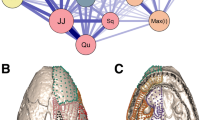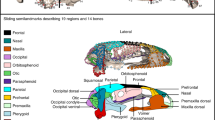Abstract
Studies of sequence heterochrony in mammalian evolution have revealed differences in bone ossification between and within major clades. Sequences of late stage developmental events have been less well studied, and the relation of modularity to sequence heterochrony at these stages has not been explicitly tested. Here, the first data on cranial suture closure are provided for members of Sciuridae. Sequence heterochrony is quantified using the recently developed Parsimov-based genetic inference (PGi) algorithm to identify shifts in suture closure sequence, and modularity in heterochronic shifts is tested. Results indicate that suture closure pattern was quite variable among sciurids, and interspecific correspondence in closure sequence was generally lower than has been found for other rodents, and for carnivorans. A number of sequence heterochronies were detected for inclusive clades, and these were not randomly distributed but mainly concentrated among sutures that exhibited high rank variability and belonged to the orbit and cranial vault modules, suggesting that some regions of the cranium exhibited a greater capacity for variation in suture closure. Heterchronies were not detected for sutures belonging to the basicranium, or anterior orbit-nasal modules, both of which are recognized as highly integrated modules based on landmark data. Modularity of suture closure sequence was not significant for any modules following multiple-comparison correction, which contrasts with modularity that has been recovered in early stage, ossification sequence events among other mammals.


Similar content being viewed by others
References
Alberch P, Gould SJ, Oster GF, Wake DB (1979) Size and shape in ontogeny and phylogeny. Paleobiology 5(3): 296–317
Bärmann EV, Sánchez-Villagra MR (2012) A phylogenetic study of late growth events in a mammalian evolutionary radiation – the cranial sutures of terrestrial cetartiodactyl mammals. J Mammal Evol 19: 43–56
Bininda-Emonds ORP, Jeffrey JE, Richardson MK (2003) Is sequence heterochrony an important evolutionary mechanism in mammals? J Mammal Evol 10: 335–361
Black CC (1963) A review of the North American Tertiary Sciuridae. Bull Mus Comp Zool Harv 130:109–248
Blomquist GE (2008) Methods of sequence heterochrony for describing modular developmental changes in human evolution. Am J Phys Anthropol 138: 231–238
Bolker JA (2000) Modularity in development and why it matters to evo-devo. Am Zool 40: 770–776
Brunner S, Bryden MM, Shaughnessy PD (2004) Cranial ontogeny of otariid seals. Syst Biodivers 2: 83–110
Byron CD, Borke J, Yu J, Pashley D, Wingard CJ, Hamrick M (2004) Effects of increased muscle mass on mouse sagittal suture morphology and mechanics. Anat Rec 279A: 676–684
Cardini A, O’Higgins P (2005) Post-natal ontogeny of the mandible and ventral cranium in Marmota (Rodentia, Sciuridae): allometry, epigenetics and phylogeny. Zoomorphology 124: 189–203
Chopra SRK (1957) Cranial suture closure in monkeys. Proc Zool Soc London 128: 67–112
Fabre P-H, Hautier L, Dimitrov D, Douzery EJP (2012) A glimpse on the pattern of rodent diversification: a phylogenetic approach. BMC Evol Biol 12: 88
Goswami A (2006) Cranial modularity shifts during mammalian evolution. Am Nat 168: 270–280
Goswami A (2007) Cranial modularity and seqeuence heterochrony in mammals. Evol Dev 9(3): 290–298
Goswami A, Polly PD (2010) Methods for studying morphological integration and modularity. In: Alroy J, Hunt G (eds) Quantitative Methods in Paleobiology, The Paleontological Society Papers, Vol 16, The Paleontology Society, pp 213–243
Goswami A, Weisbecker V, Sánchez-Villagra MR (2009) Developmental modularity and the marsupial-placental dichotomy. J Exp Zool 312B: 186–195
Goswami A, Foley L, Weisbecker V (2013) Patterns and implication of extensive heterochrony in carnivoran cranial suture closure. J Evol Biol doi: 10.1111/jeb.12127
Gould SJ (1977) Ontogeny and Phylogeny. Belknap Press, Cambridge
Gould SJ (1982) Changes in developmental timing as a mechanism of macroevolution. In: Bonner JT (ed) Evolution and Development. Springer Verlag, New York, pp 333–346
Harrison LB, Larsson HCE (2008) Estimating evolution of temporal sequence changes: a practical approach to inferring ancestral developmental sequences and sequence heterochrony. Syst Biol 57: 378–387
Hautier L, Weisbecker V, Goswami A, Knight F, Karjilov N, Asher RJ (2011) Skeletal ossification and sequence heterochrony in xenarthran evolution. Evol Dev 13(5): 460–476
Hautier L, Bennett NC, Viljoen H, Howard L, Milinkovitch MC, Tzika AC, Goswami A, Asher AJ (2013) Patterns of ossification in southern versus northern placental mammals. Evolution 67(7): 1994–2010
Herring SW (1972) Sutures – a tool in functional cranial analysis. Acta Anat 83: 222–247
Herring SW (1974) A biometric study of suture fusion and skull growth in peccaries. Anat Embryol 146: 167–180
Herring SW (2008) Mechanical influences on suture development and patency. Front Oral Biol 12: 41–56
Hoson O, Kawada S-I, Oda S-I (2012) Ossification patterns of basicranial sutures in manatees, genus Trichechus. Mammal Study 37(3): 213–225
Jaslow CR, Biewener AA (1995) Strain patterns in the horcores, cranial bones and sutures of goats (Capra hircus) during impact loading. J Zool 235: 193–210
Jeffery JE, Bininda-Emonds ORP, Coates MI, Richardson MK (2002) Analyzing developmental sequences within a phylogenetic framework. Syst Biol 51: 478–491
Jeffery JE, Bininda-Emonds ORP, Coates MI, Richardson MK (2005) A new technique for identifying sequence heterochrony. Syst Biol 54: 230–240
Klingenberg CP (1998) Heterochrony and allometry: the analysis of evolutionary change in ontogeny. Biol Rev 73(1):79–123
Klingenberg CP (2013) Cranial integration and modularity: insights into evolution and development from morphometric data. Hystrix doi: 10.4404/hystrix-24.1-6367
Koyabu D, Endo H, Mitgutsch C, Suwa G, Catania KC, Zollikofer CPE, Oda S-I, Koyashu K, Ando M, Sánchez-Villagra MR (2011) Heterochrony and developmental modularity of cranial osteogenesis in lipotyphlan mammals. EvoDevo 2: 21
Krogman WM (1930) Studies in growth changes in the skull and the face of anthropoids II: ectocranial and endocranial suture closure in anthropoids and Old World apes. Am J Anat 46(2): 315–353
Kuratani S (2005) Craniofacial development and the evolution of vertebrates: craniofacial development and the evolution of the vertebrates: the old problems on a new background. Zoo Sci 22: 1–19
Marroig G, Shirai LT, Porto A, de Oliveira FB, De Conto V (2009) The evolution of modularity in the mammalian skull II: evolutionary consequences. Evol Biol 36: 136–148
Maxwell EE, Harrison LB, Larsson HCE (2010) Assessing the phylogenetic utility of sequence heterochrony: evolution of avian ossification sequences as a case study. Zoology 113: 57–66
Mercer JM, Roth VL (2003) The effects of Cenozoic global change on squirrel phylogeny. Science 299:1568–1572
Michaux J, Hautier L, Simonin T, Vianey-Liaud M (2008) Phylogeny, adaptation and mandible shape in Sciuridae (Rodentia, Mammalia). Mammalia 72: 286–296
Moazen M, Curtis N, O’Higgins P, Jones ME, Evans SE, Fagan MJ (2009) Assessment of the role of sutures in a lizard skull: a computer modelling study. Proc Roy Soc Lond B 276: 39–46
Moore JC (1959) Relationships among the living squirrels of the Sciurinae. Bull Am Mus Nat Hist 118(4):157–206
Nicolay CW, Vaders MJ (2006) Cranial suture complexity in white-tailed deer (Odocoileus virginianus). J Morphol 267: 841–849
Olson EC, Miller RL (1958) Morphological Integration. University of Chicago Press, Chicago
Olson ME, Rosell JA (2006) Using heterochrony to detect modularity in the evolution of stem diversity in the plant family Moringaceae. Evolution 60: 724–734
Opperman LA (2000) Cranial sutures as intramembranous growth sites. Dev Dyn 219: 472–485
Poe S (2004) A test for patterns of modularity in sequences of developmental events. Evolution 58: 1852–1855
Porto A, de Oliveira FB, Shirai LT, De Conto V, Marroig G (2009) The evolution of modularity in the mammalian skull I: morphological integration patterns and magnitudes. Evol Biol 36: 119–135
Raff RA (1996) The Shape of Life. University of Chicago Press, Chicago
Rager L, Hautier L, Forasiepi A, Goswami A, Sánchez-Villagra MR (2013) Timing in cranial suture closure in placental mammals: phylogenetic patterns, intraspecific variation and comparison with marsupials. J Morphol in press
Rayfield EJ (2005) Using finite-element analysis to investigate suture morphology: a case study using large carnivorous dinosaurs. Anat Rec 283A: 349–365
Rice DP (2008) Developmental anatomy of craniofacial sutures. Front Oral Biol 12: 1–21
Roth VL (1996) Cranial integration in the Sciuridae. Am Zool 36(1): 14–23
Samuels JX (2009) Cranial morphology and dietary habits of rodents. Zool J Linn Soc 156: 864–888
Sánchez-Villagra MR (2002) Comparative patterns of postcranial ontogeny in therian mammals: an analysis of relative timing of ossification events. J Exp Zool 294: 264–73
Sánchez-Villagra MR (2010) Developmental palaeontology in synapsids: the fossil record of ontogeny in mammals and their closest relatives. Proc R Soc Lond B 277: 1139–47
Sánchez-Villagra MR, Goswami A, Weisbecer V, Mock O, Kuratani S (2008) Conserved relative timing of cranial ossification patterns in early mammalian evolution. Evol Dev 10: 519–530
Schoch RR (2006) Skull ontogeny: developmental patterns of fishes conserved across major tetrapod clades. Evol Dev 8: 524–536
Schulmeister S, Wheeler WC (2004) Comparative and phylogenetic analysis of developmental sequences. Evol Dev 6: 50–57
Sears KE (2009) Differences in the timing of prechondrogenic limb development in mammals: the marsupial-placental dichotomy resolved. Evolution 63(8): 2193–2200
Smith KK (1997) Comparative patterns of craniofacial development in eutherian and metatherian mammals. Evolution 51: 1663–1678
Smith KK (2002) Sequence heterochrony and the evolution of development. J Morphol 252: 82–97
Todd TW, Lyon D (1924) Endocranial suture closure: its progress and age relationship. I. Adult males of white stock. Am J Phys Anthropol 7: 325–384
Todd TW, Lyon D (1925) Cranial suture closure: its progress and age relationship. II. Ectocranial suture closure of males of white stock. Am J Phys Anthropol 8: 23–43
Trainor PA, Tan SS, Tam PP (1994) Cranial paraxial mesoderm: regionalisation of cell fate and impact on craniofacial development in mouse embryos. Development 120: 2397–2408
Velhagen WA (1997) Analyzing developmental sequences using sequence units. Syst Biol 46: 204–210
Wagner GP, Pavlicev M, Cheverud JM (2007) The road to modularity. Nat Rev Genet 8: 921–31
Wang Q, Opperman LA, Havill LM, Carlson DS, Dechow PC (2006) Inheritance of sutural pattern at the pterion in Rhesus monkey skulls. Anat Rec 288A: 1042–1049
Weisbecker V (2011) Monotreme ossification sequences and the riddle of mammalian skeletal development. Evolution 65: 1323–35
Weisbecker V, Goswami A, Wroe S, Sánchez-Villagra MR (2008) Ossification heterochrony in the therian postcranial skeleton and the marsupial-placental dichotomy. Evolution 68(2): 2027–2041
Wilson LAB (2013) Allometric disparity in rodent evolution. Ecol Evol 3(4): 971–984
Wilson LAB, Sánchez-Villagra MR (2009) Heterochrony and patterns of cranial suture closure in hystricognath rodents. J Anat 214:339–354
Wilson LAB, Sánchez-Villagra MR (2010) Diversity trends and their ontogenetic basis: an exploration of allometric disparity in rodents. Proc R Soc Lond B Bio 277:1227–1234
Wilson LAB, Schradin C, Mitgutsch C, Galliari FC, Mess A, Sánchez-Villagra MR (2010) Skeletogenesis and sequence heterochrony in rodent evolution, with particular emphasis on the African striped mouse, Rhabdomys pumilio (Mammalia). Org Divers Evol 10: 243–258
Zelditch ML, Mezey J, Sheets HD, Lundrigan BL, Garland T Jr (2006) Developmental regulation of skull morphology II: ontogenetic dynamics of covariance. Evol Dev 8(1): 46–60
Acknowledgments
This work was supported by grants from the Japanese Society for the Promotion of Science (PE10075) and the Swiss National Science Foundation (PBZHP3_141470). For help with access to specimens, I thank Daisuke Koyabu (University of Tokyo), Tatsuo Oshida (Obihiro University of Agriculture and Veterinary Medicine, Hokkaido), Masaru Kato and Fumihito Takaya (Botanic Garden, Hokkaido University, Sapporo), Ibnu Maryanto (Indonesian Institute of Sciences, Bogor), Louise Tomsett and Roberto Portela Miguez (Natural History Museum, London), David Stemmer (South Australian Museum, Adelaide), and Sandy Ingleby (Australian Museum, Sydney). For general discussion on aspects of heterochrony and modularity, I thank Marcelo Sánchez, Anjali Goswami, Daisuke Koyabu, Robin Beck, and Vera Weisbecker. For hospitality during data collection in London, I thank Louise Humphrey and Christophe Soligo.
Author information
Authors and Affiliations
Corresponding author
Rights and permissions
About this article
Cite this article
Wilson, L.A.B. Cranial Suture Closure Patterns in Sciuridae: Heterochrony and Modularity. J Mammal Evol 21, 257–268 (2014). https://doi.org/10.1007/s10914-013-9242-5
Published:
Issue Date:
DOI: https://doi.org/10.1007/s10914-013-9242-5




